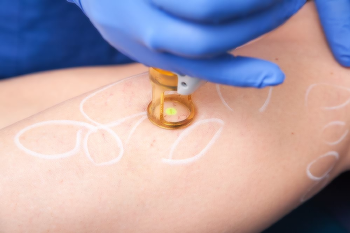Optimal outcomes of laser-assisted hair removal are obtained with the highest fluences, appropriate pulse duration, and the largest laser spot size... Continue Reading →
Optimal outcomes of laser-assisted hair removal are obtained with the highest fluences, appropriate pulse duration, and the largest laser spot size. Test spots may be performed prior to treatment of larger areas to determine to highest fluence tolerated by the individual patient and the laser’s effect on surrounding skin. The amount of fluence used should also depend upon the area of the body to be treated and the density of hairs at the site.
In areas with thick, dense hairs, such as the beard area or upper back in men or the bikini area in women, a lower fluence should be used until the hair has sufficiently thinned. Epidermal damage could otherwise occur, due to the additive thermal energy absorbed by the higher density of hair follicles.
When treating the brow area on men or women, the skin should be pulled up and away from the eyes and should overlay a flat portion of the forehead. This helps minimize the risk of laser light exposure to the eye and retina.
A higher occurrence of adverse effects and adverse reactions has been noted at the neck region in women; higher fluences in this area should be used with caution.
For treatment of the chin, perioral region, or upper lip, tooth enamel should be protected from excessive laser light exposure. Inappropriate exposure to certain laser light may induce hard tissue disintegration in the tooth and irreversible damage to dental pulp.
To minimize the possibility of thermal damage to skin and to improve patient comfort, the skin should be cooled during laser-assisted hair removal. As previously stated, all FDA-approved laser systems have an epidermal cooling device incorporated into the handpiece. Incorporated cooling mechanisms currently in use include cryogen sprays, sapphire-cooled handpieces, and cold airflow.

Cryogen sprays are used in short bursts prior to each pulse of laser light. Increasing the length of cryogen spurts can decrease the pain felt by the patient.
A pre-cooled, heatsinked sapphire window or water-cooled glass window can be incorporated into the laser handpiece. This comes into contact with the skin to be treated and cools the skin.
Some laser handpieces contain a source of continuously cooled air. This cold air is blown over the area to be treated and cools the skin during laser treatment.
Cold compresses or ice packs may be used prior to treatment, along with cooled laser handpieces. These may be applied prior to treatment or intermittently during a longer treatment time.
Application of a cooling gel (eg, ultrasound, aloe vera) to the skin can aid in minimizing discomfort and epidermal damage. All gel must, however, be thoroughly removed from the skin prior to treatment.
A recent study has introduced a pneumatic skin flattening (PSF) device as an alternative to the dynamic cooling devices that are currently used. This device generates a negative pressure on a small area of the patient’s skin, elevating and flattening the skin onto a sapphire window in preparation for laser therapy. This feeling of pressure against the skin may block the sensation of pain experienced by the patient. Study results thus far show that this method of treatment can be successful.
During laser treatment, each laser spot should overlap by no more than one-third of the spot size. Further overlapping of continuous pulses causes accumulation of thermal injury and potentially causes epidermal damage. No overlapping of spots could result in missed areas in the treatment area. A treatment grid could be applied to the patient’s skin and used as a guideline to outline the treatment area. With experience, the laser operator becomes proficient in visually tracking the treatment area.
Postoperative Details
Immediately after a treatment session, patients should be given a cold compress or ice pack to decrease pain and reduce swelling. This effectively reduces discomfort, edema, and erythema, and keeps epidermal adverse effects to a minimum.
Patients may also be given a topical corticosteroid cream to decrease local erythema.
If minor skin damage has occurred, a topical antibiotic ointment may be applied until the skin has sufficiently healed.
For more serious skin damage, an oral antibiotic may be prescribed for prophylaxis if deemed necessary by the health care provider.
Makeup may be applied to treated areas the day following the procedure, as long as no epidermal damage has occurred.
Patients should be told that hair casts will shed from treated areas over the following week and that this should not be confused with new hair growth.